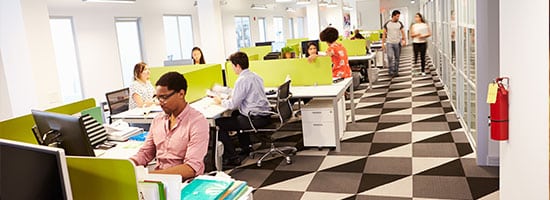If you find yourself having a “case of the Mondays” all day, every day, you might want to re-think your office environment. Creating a productive workspace is more than just hanging some team-building posters on the walls and choosing carpet; a well-designed office space makes work more enjoyable and makes you more relaxed and productive.
Here are several fresh ways to create a relaxed and efficient office environment.
Include both open and closed spaces
Traditional office layouts have typically been an outer ring of executive offices with a group of cubicles in the center. The floor plans tend to be open-concept, interrupted by cubicle walls. These types of offices have been shown to limit communication and slow response times in responding to client needs.
A survey by office furniture retailer Steelcase found that close to 90 percent of workers worldwide are unhappy with their office arrangement, citing a lack of privacy as the main issue.
Collaboration is great, but a little privacy goes a long way in helping a worker to focus without interruption. In fact, of the workers surveyed who were happy with their office setup, 88 percent said that their workspace allowed them to concentrate easier and choose where to work based on what tasks they were doing.
Forcing employees into environments that are saturated with stimuli will harm long-term satisfaction and productivity, so arrange the floor to include task-specific areas, including spaces deliberately free of external noise.
Color and lighting
Offices that are dim, with overhead fluorescent lighting, are depressing places to work. Change out the lighting to include a warmer color spectrum, and diffuse the lighting from several sources, if possible.
Colors have been proven to influence moods, and an office that instantly fouls up your mood is not the place to spend 40 or more hours each week. So lighten it up and use quiet, relaxing color schemes in the work areas where the majority of the day is spent. Bright, loud colors have their place in areas specifically designed for high-energy events, such as a morning sales meeting.
Furniture, ergonomics, and clutter
The money spent on office furniture should be viewed as an investment more than an expense. Spending a few more dollars on a chair that you are going to occupy for most of the day is worth it if the alternative is having to shift around every 10 minutes to get comfortable. Also, don’t overlook ergonomics. Make sure that your desk(s) and chairs are built to match in height and function.
In an efficient office, there is a place for everything, and everything is kept in its place. In other words, there should be zero clutter. Excessive clutter creates frustration and is the enemy of productivity and focus. You should know where everything is at any given time.
Tie these together to create harmony
The goal when laying out an office space is that you and those who work with you feel relaxed and able to focus when in their office space. Create an environment that fosters collaboration and communication, yet also values personal space. Balance this with a calming light and color scheme and a clean space with comfortable furniture, and you’ve placed your office in the top 10 percent worldwide in terms of employee satisfaction.
